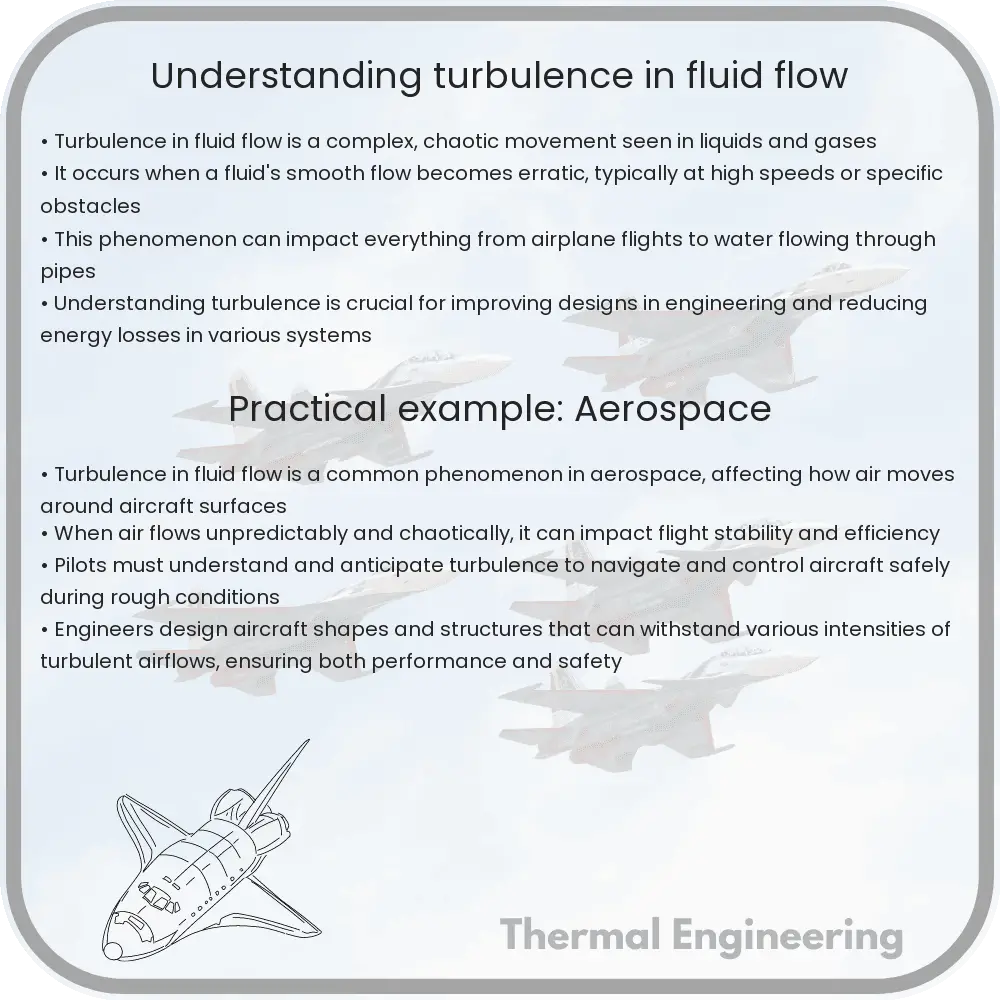Explore the dynamic and chaotic nature of turbulence in fluid flow, a crucial concept impacting engineering, meteorology, and environmental science.

Understanding Turbulence in Fluid Flow
Turbulence in fluid flow is a complex phenomenon observed in various natural settings and engineering applications. From the flow of rivers and atmospheric weather patterns to the design of aircraft and pipelines, understanding turbulence is crucial for predicting and managing fluid behavior. In this article, we’ll dive into what turbulence is, why it matters, and the basic principles underlying this dynamic state of fluid motion.
What is Turbulence?
Turbulence is a type of fluid motion characterized by chaotic, stochastic property changes. This includes low momentum diffusion, high momentum convection, and rapid variation of pressure and velocity in space and time. Unlike laminar flow, where the fluid flows in smooth layers, turbulent flow is marked by swirling and eddying motions.
Characteristics of Turbulent Flow
- Irregularity: Turbulent flow is chaotic and unpredictable.
- Diffusivity: Enhanced mixing and increased mass, momentum, and energy transfer.
- Rapid Variation: Fluctuations in speed and pressure occur without regular frequency.
- Viscosity Dominance: In turbulent flow, internal friction forces (viscosity) play a significant role.
Factors Contributing to Turbulence
The onset of turbulence can be influenced by several factors:
- Velocity of the Fluid: Higher speeds increase the likelihood of turbulence.
- Viscosity of the Fluid: Lower viscosity fluids are more prone to turbulence.
- Characteristics of the Flow Path: Obstacles or sharp turns in the flow path can induce turbulence.
Mathematical Description of Turbulence
The mathematical analysis of turbulent flows is principally governed by the Navier-Stokes equations, a set of nonlinear differential equations that describe the motion of viscous fluid substances. These equations are given by:
\[\frac{\partial \mathbf{u}}{\partial t} + (\mathbf{u} \cdot \nabla) \mathbf{u} = -\frac{1}{\rho} \nabla p + \nu \nabla^2 \mathbf{u} + \mathbf{f}\]
where:
- \(\mathbf{u}\) – velocity field
- \(t\) – time
- \(\rho\) – density of the fluid
- \(p\) – pressure field
- \(\nu\) – kinematic viscosity
- \(\mathbf{f}\) – external forces (e.g., gravity)
Due to the complexity of these equations, exact solutions can rarely be found, and numerical methods or simplified models are often used in practical applications.
Practical Implications of Understanding Turbulence
The study of turbulence has profound implications in various fields:
- Engineering Design: Aircraft and automobiles are designed considering the effects of turbulence to improve performance and safety.
- Meteorology: The forecasting of weather patterns relies heavily on understanding the turbulent flow of the atmosphere.
- Medical Applications: In cardiovascular disease research, studying the turbulent flow of blood can provide insights into the causes and treatments of conditions.
- Environmental Science: Turbulence plays a key role in the dispersion of pollutants in air and water, affecting environmental assessments and mitigation strategies.
Understanding turbulence and its effects allows engineers and scientists to predict and mitigate its impact, leading to advances in technology and improvement in the quality of life.
Conclusion
Turbulence in fluid flow represents one of the most challenging areas in fluid dynamics. While it presents complexities in prediction and management, advancements in computational fluid dynamics and ongoing research continue to peel back the layers of this chaotic yet fascinating phenomenon. With continued study, the hope is to harness and manage turbulence for technological and environmental benefits.